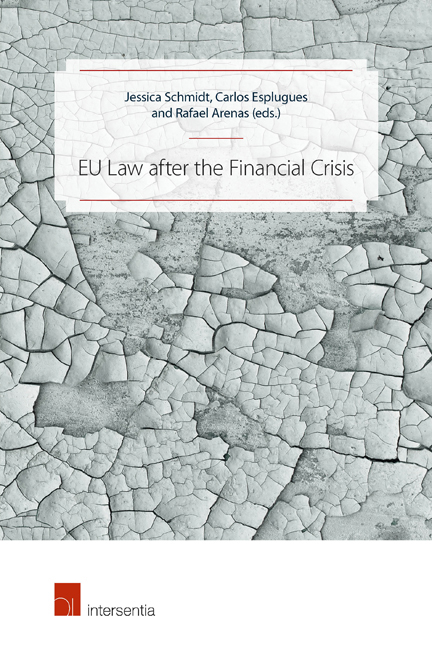Book contents
- Frontmatter
- Contents
- List of Abbreviations
- List of Authors
- Introduction
- PART I RESCUE MECHANISMS AND MONETARY POLICY
- PART II THE IMPACT OF THE FINANCIAL CRISIS ON THE BANKING SECTOR AND CAPITAL MARKETS
- PART III THE FINANCIAL CRISIS AND TAX LAW
- PART IV THE FINANCIAL CRISIS, CONSUMERS AND CONSUMER LAW
- PART V THE FINANCIAL CRISIS AND COMPETITION LAW
- PART VI THE FINANCIAL CRISIS, RESTRUCTURING AND INSOLVENCY LAW
- Universal versus Individual Transfers of Assets and Liabilities. A Conflict-of-Laws Perspective
- Financial Crisis and European Insolvency Law
- International Arbitration and vis attractiva concursus
- PART VII THE SOCIAL DIMENSION OF THE FINANCIAL CRISIS AND EU CITIZENSHIP
- PART VIII REFLECTIONS ON THE IMPACT OF THE FINANCIAL CRISIS ON THE GENERAL EUROPEAN LEGAL FRAMEWORK AND THE FUNDAMENTAL “EUROPEAN IDEA”
Universal versus Individual Transfers of Assets and Liabilities. A Conflict-of-Laws Perspective
from PART VI - THE FINANCIAL CRISIS, RESTRUCTURING AND INSOLVENCY LAW
Published online by Cambridge University Press: 13 December 2017
- Frontmatter
- Contents
- List of Abbreviations
- List of Authors
- Introduction
- PART I RESCUE MECHANISMS AND MONETARY POLICY
- PART II THE IMPACT OF THE FINANCIAL CRISIS ON THE BANKING SECTOR AND CAPITAL MARKETS
- PART III THE FINANCIAL CRISIS AND TAX LAW
- PART IV THE FINANCIAL CRISIS, CONSUMERS AND CONSUMER LAW
- PART V THE FINANCIAL CRISIS AND COMPETITION LAW
- PART VI THE FINANCIAL CRISIS, RESTRUCTURING AND INSOLVENCY LAW
- Universal versus Individual Transfers of Assets and Liabilities. A Conflict-of-Laws Perspective
- Financial Crisis and European Insolvency Law
- International Arbitration and vis attractiva concursus
- PART VII THE SOCIAL DIMENSION OF THE FINANCIAL CRISIS AND EU CITIZENSHIP
- PART VIII REFLECTIONS ON THE IMPACT OF THE FINANCIAL CRISIS ON THE GENERAL EUROPEAN LEGAL FRAMEWORK AND THE FUNDAMENTAL “EUROPEAN IDEA”
Summary
INTRODUCTION
In times of economic recession, companies resort to restructuring as an efficient tool to overcome financial difficulties. Changes of legal structure, such as transformations, mergers, divisions and global or partial transfer of assets and liabilities may offer a solution to re-balance the economic situation of a firm. One of the typical consequences of such restructuring is the universal transfer of assets and liabilities, by operation of law, from one company to another. This may include assets located abroad or contracts and liabilities governed by foreign law. The purpose of this chapter is to analyse the conflict-of-laws problems caused by these types of operations and to suggest some proposals, from a de lege ferenda perspective, to solve them. It pays particular attention to the current EU legal framework on such transactions.
INDIVIDUAL VERSUS UNIVERSAL TRANSFER OF ASSETS
Most EU legal systems envisage the difference between individual and universal transfers of assets.
INDIVIDUAL TRANSFER OF ASSETS
Individual transfers refer to transfers of an asset, a contract or a liability utisinguli. These transfers entail a singular succession from the transferor to the transferee (Einzelrechtsnachfolge), and are governed by general rules of civil and commercial law. Thus, for example, according to the Spanish Civil Code, the assignment of liability claims requires the consent of the counterparty. Since the features of a debtor, in particular its financial solvency, may be a key element for its creditor, a change of the former must not take place against the will of the latter. With regard to assets, an individual transfer of a tangible asset requires a valid contract and the delivery of such asset. Until these requirements are met, the asset remains in the transferor's patrimony.
Example. If A has concluded a contract with B and wants to assign such contract (rights and liabilities) to a third party, according to the Spanish Civil Code (CC), B's consent is required (Article 1205 CC). This is also the general rule in other legal systems. If A wants to transfer the property of a tangible asset to B, according to the Spanish Civil Code both a valid contract and the physical delivery of the asset (traditio) are required (Article 609 CC). In other legal systems either a valid contract or the physical delivery (with an agreement to transfer the property) may be sufficient.
- Type
- Chapter
- Information
- EU Law after the Financial Crisis , pp. 211 - 226Publisher: IntersentiaPrint publication year: 2016



